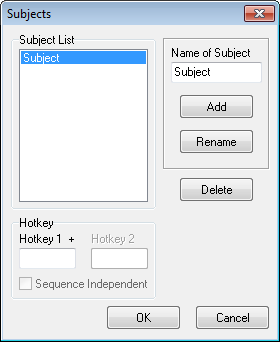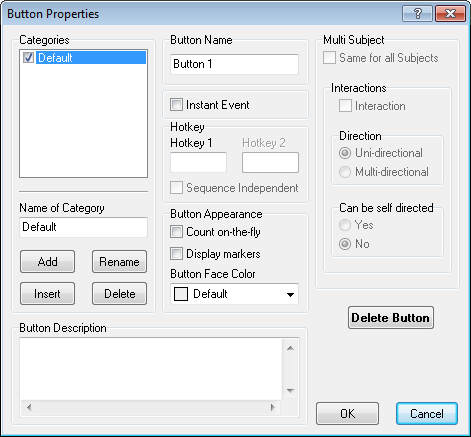
Contents - Index - Previous - Next
Multiple Subjects and Coding Interactions
It makes sense to define Multiple Subjects if the individuals are identical to each other, in the sense that for each and every one of them the same behaviors are coded. When multiple subjects are defined then each subject has its own coding sheet where data can be recorded. The user can change between the coding sheets by clicking on the subject selector above the coding sheet. Subjects can be defined while being in workspace config mode by right clicking on the subject selector.

Add: Add a new subject to the end of the subject list. The new subject will have the name typed into the Name of Subject box.
Rename: Change the name of the actually selected subject to the one in the Name of Subject box.
Delete: Delete the actually selected subject. At least one subject has to remain in the list. The program will not let the user to delete the last remaining subject.
Hotkey: The hotkey panel can be configured the same way as in the Button Properties window. Defining a hotkey will switch the coding sheet to the given subject when pressing it. The user can also toggle through subjects by pressing the Tab key.
When more than one subject is defined then it is possible to define behavior elements as Interactions. Interactions differ from simple behavior elements in that they have one or more subjects as targets. This additional information is stored with the behavior element in the coding sheet, and during analysis enables to get results separately for behaviors with different targets. This differentiation is not supported in Combined Frequencies and Combined Durations.

The right side panel of the Button Properties window serves for configuring multi subject related attributes.
Same for all Subjects: With this attribute checked, the behavior element will register into all subjects' coding sheets, regardless which one is currently active. It should be checked for marker elements.
Interaction: Defines whether the behavior element is an interaction or not.
Uni-directional / Multi-directional: Defines whether the behavior element can have one or multiple subjects as targets.
Can be self directed: Defines whether the behavior element activated at a certain subject can target the same subject.